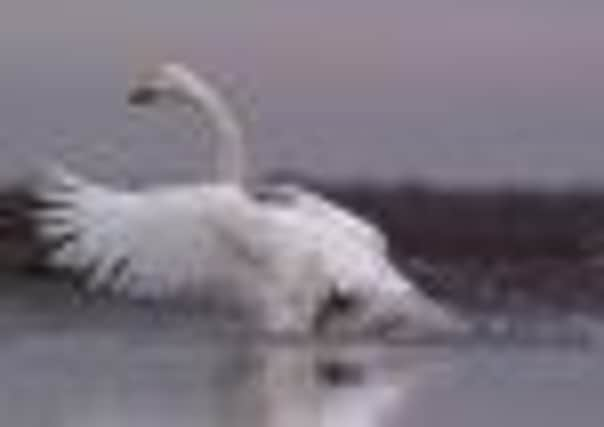Swans down to escape dark chill of the Arctic


The impressively noisy Whooper swan and the smaller, rarer Bewick’s are tough birds, but not tough enough to cope with the permanent dark and unremitting chill of an Arctic winter.
Some 16,000 Whoopers, (more than half the entire population), and 7,000 Bewick’s swans (a third of the world’s total number) see out the worst of the cold in the comparatively balmy UK.
Advertisement
Hide AdAdvertisement
Hide AdIt was once believed that swans represented the souls of the dead, and there is something undeniably eerie about the site and sound of a wild flock glowing white in the twilight of a winter saltmarsh.
The Whooper is bigger, only slightly shorter than our ubiquitous Mute swan. It has a thinner, more elegant neck than the Bewick’s, often with a kink at the base.
The Whooper’s yellow markings extend beyond the nostrils – they don’t even get close on the Bewick’s.
The term swansong is thought to come from the ancient belief that swans let out a plaintive note as they died, but in life, both species are not shy about making a racket.
Advertisement
Hide AdAdvertisement
Hide AdThe majority of our over-wintering Whoopers come from Iceland. They hunker down in the northern reaches of the UK, with a few from Scandinavia touching down on our east coast.
The Bewick’s, named after a Victorian illustrator, is an altogether more elusive beast.
Breeding in Russia, the birds congregate on a handful of sites, generally further south than the Whooper.
Wildfowl and Wetlands Trust (WWT) reserves hold a huge percentage of our swan populations and it was work at WWT’s Slimbridge headquarters in Gloucestershire that paved the way for how we understand their needs today.WWT swan expert Julia Newth explains: “The Bewick’s were first attracted to the reserve through the efforts of founder Sir Peter Scott.
Advertisement
Hide AdAdvertisement
Hide Ad“He built a specially designed lake for the swans which enabled them to winter here safely. It provided a predator-free roost site, supplementary food and good grazing on the reserve.
“He attracted the first birds in the 1950s using some decoy Whistling swans which have a very similar call to the Bewick’s.
The Bewick’s are very site faithful, and numbers steadily grew.
“By the late 1970s, there were 400 swans or so visiting the reserve each winter.” Scott realised each bird had a unique bill pattern. Identifying individuals helped experts to study family behaviour and survival needs of the birds in a far more specific way than previously possible.
Advertisement
Hide AdAdvertisement
Hide AdThey found out that the birds showed great site fidelity - more than half of the swans recorded had visited Slimbridge before.
They mate for life. The longest partnership recorded was between Limonia and Laburnum who visited Slimbridge together for 21 years.
Over the years some birds became firm favourites and high on that list was Crinkly, whose deformed neck defined her name.
However, she has not been seen for the last three years.
The pressure on Whooper and particularly Bewick’s swans is mounting.
Climate change, habitat destruction and illegal shooting all loom large over their continued survival.
www.wwt.org.uk